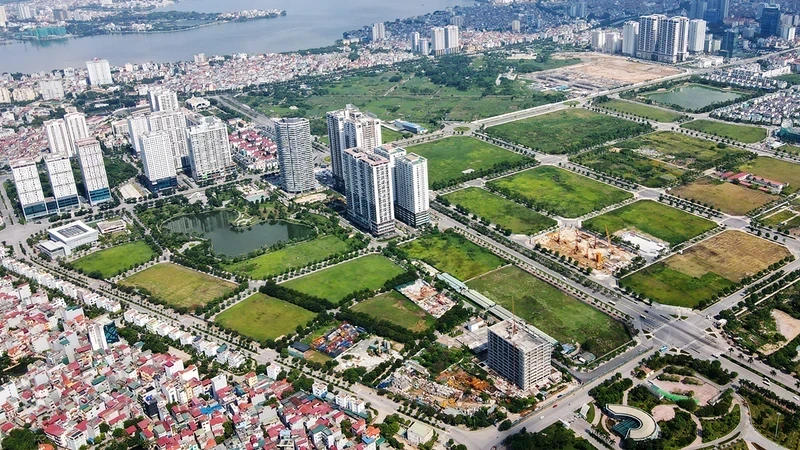Land information disclosure is a matter regulated by law. In recent years, many localities have changed the publication of land price lists, planning, and land use plans on electronic information portals. However, some localities only partially disclose, disclose late, or do not respond to information requests, limiting investment opportunities and information transparency.

Photo for illustration. (Photo: Tue Nghi)
The United Nations Development Program, Real-time Analysis Company, and the Centre for Promoting Education and Empowering Women have coordinated to publish land information disclosure on electronic information portals of authorities at all levels in 63 provinces and cities.
This is the result of a study conducted by the research team from 2021 to 2024, the scope of the survey focused on three groups of contents: provincial land price list (2020-2024 period), district-level land use planning (2021-2030 period) and district-level land use planning (by year).
Accordingly, 53 out of 63 provinces and centrally run cities have publicly posted land price lists; nearly 71% of the total number of district-level People’s Committees have publicly announced land use plans; more than 450 land use planning records have been publicly announced on the district’s electronic information portal.
The electronic information pages of the provincial People’s Committee or the Department of Natural Resources and Environment (now the Department of Agriculture and Environment) are designed to be coherent, easy to use, and support quick searching. In some places, the planning map is also integrated into the page. Viewers can zoom in, zoom out or search by coordinates and boundaries to see the area they are interested in. These prove that when local authorities are determined, this work is not too difficult and brings great social efficiency.
However, there are still many limitations, such as the timeliness of information disclosure. In many cases, planning documents and land use plans have been approved for a long time but are slow to be posted on the information pages of the People’s Committees at the district or provincial level, leading to people and businesses missing out on business opportunities or protecting their rights.
Even when the content has been posted, some places are in a state of “lost links”, or some localities only post part of the documents, such as information that only has the approval decision but lacks a map or explanatory report, making it difficult for viewers to understand the details of the planning.
In addition, when there are changes in content, some provincial and district information pages rearrange categories and layouts, making it difficult for people and businesses to look up information. In addition, the inadequacy of technical infrastructure, human resources and financial resources is still a barrier.
According to regulations, the publication of land documents often includes large documents, photos and maps, so if there is no investment or lack of staff, the information page can easily become overloaded and the links can break.
Notably, with the policy of streamlining the apparatus and not organising district-level governments, the issue of information disclosure is even more urgent. When the district level is still in place, planning and documents are managed by the district government. But when the district level is abolished, leaving only two administrative levels, this task can be transferred to the provincial or commune level.
Therefore, when rearranging the organisational apparatus, it is also necessary to clarify the mechanism for receiving and publishing data, updating land use plans, land use planning, etc. These are issues that need to be resolved promptly to ensure continuity and avoid interruptions during the transfer process.
According to Nguyen Thi Kim Thoa, former Director of the Department of Criminal and Administrative Law, the Ministry of Justice, with the policy of only having provincial and commune-level governments, in addition to adjusting the Constitution and the Law on Organisation of Local Administration, it is also necessary to study, review and simultaneously amend relevant legal provisions on the Land Law, Investment Law, Law on Access to Information and detailed implementation guidance documents to ensure consistency.
In addition, it is necessary to ensure and upgrade the equipment and software needed to collect, manage, store and retrieve land data effectively. Provincial and commune-level electronic information portals must be updated to provide timely information and maintained so that people and businesses can easily search.
Localities should have a single point of contact to publish planning documents, land use plans and land price lists, avoiding each department and sector posting in a different place. Instead of each unit developing its system, centralising data into a common information portal will help people easily look up without wasting time searching through many different sources.
To do this, managers need to have close coordination between relevant agencies. In case the link changes, there should be a redirection notice or an update of the new link, so that people are not interrupted when searching. They must also complete the penalty mechanism or administrative sanctions for units that intentionally delay, do not respond or remove information without a valid reason.
Public disclosure of land information is not only a legal requirement, but also a responsibility for people to be able to access land information transparently, avoiding the risk of conflicts. Investors and businesses can also learn, creating a fair investment environment, improving land use efficiency, and promoting sustainable development. On the other hand, promoting information disclosure also means promoting the country's digital transformation and administrative reform.